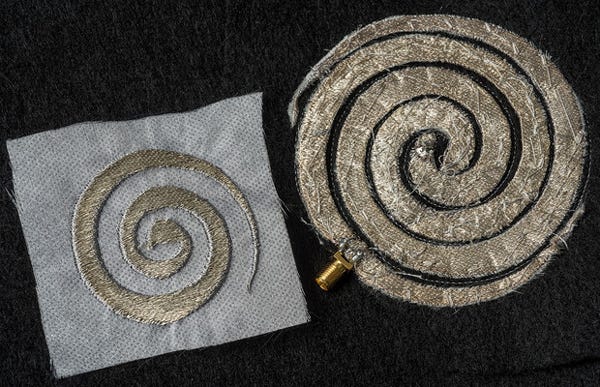Mobile Health Could Get Help From a Thing Grandmas Love
May 9, 2016
It's called embroidery. Ohio State University researchers have designed circuits that can be embroidered onto fabric with 0.1 mm precision.
Kristopher Sturgis
|
"These antennas will wirelessly transmit the sensed information to handheld devices like smartphones and tablets," says OSU research scientist Asimina Kiourti. (Image courtesy of Ohio State University) |
The market for wearable technologies continues to grow at a rapid pace, as developers look for new ways to integrate technology into clothing. Recent research from OSU details a new circuit technology that acts as an antenna--enabling wearables to gather, store, and transmit data to your smartphone or tablet.
"Sensors integrated into clothing will sense all sorts of information--like heart rate, blood pressure, oxygen levels etc.--and will further be connected to antennas that are also embroidered into clothing," says Asimina Kiourti, senior research scientist at the ElectroScience Lab at OSU, where the new circuit was developed. "These antennas will wirelessly transmit the sensed information to handheld devices like smartphones and tablets."
Kiourti says that to accomplish this, wireless technologies like Wi-Fi and Bluetooth will be used, and eventually the data should be able to be transmitted wirelessly to remote personnel such as a personal physician or to healthcare providers.
Their most recent prototype has been refined to produce wearable technologies at a fraction of the cost, and can be manufactured in half the time it took to produce similar wearables in the last few years. Kiourti says that the work is part of an initiative to create new wearable technologies that have a wide variety of applications, ranging from healthcare to human defense.
Kiourti envisions smart clothing for several different applications, including healthcare applications (sensors, stimulators, and imaging); sports applications (concussion-detecting helmets and performance metrics); space exploration (sensor-enabled spacesuits); defense applications (sensing and communication capabilities that uplift traditional army and navy uniforms); and child monitoring and fall detection for the elderly.
With so many different potential applications, the sky really could be the limit when it comes to integrating wearables with technology. At this year's CES conference, there were all kinds of new wearable devices on display. However, despite all the new, flashy gadgetry showcased at the conference, there weren't many medtech wearables that reached beyond the realm of fitness tracking--something Kiourti and her colleagues hope to address with their work.
"At OSU we are working on a new class of wireless and batteryless brain implants," she says. "These implants are wirelessly activated by an interrogator that is embroidered into a flexible fabric cap. Upon interrogation, the implants sense deep brain signals, and backscatter this information wirelessly to the fabric. This approach has tremendous impact for applications like epilepsy, Parkinson's, and tremors. For example, the flexible cap could 'sense' when an epileptic seizure is about to occur, and warn the patient accordingly, or even better, stimulate the brain and help prevent the upcoming seizure."
As the group moves forward in their research, Kiourti and her colleagues remain hopeful that their work can serve as the groundwork for a new generation of smart clothing and wearable technologies that can be both cost efficient and highly functionalized.
"Wearable products are slowly coming into the market," she says. "We believe that wearable electronics will really catch on within the next couple of years. Our technology promises low-cost, unobtrusive and high functionalized garments and accessories for all sorts of applications from sports to healthcare and beyond. Our textiles are flexible, washable, robust, and perform as good as copper for frequencies up to a few GHz. We will keep working to develop breakthrough technology for the nation's textile industry."
Learn more about cutting-edge medical devices at MD&M East, June 14-15, 2016 in New York City. |
Kristopher Sturgis is a contributor to Qmed and MPMN.
Like what you're reading? Subscribe to our daily e-newsletter.
About the Author(s)
You May Also Like


.png?width=300&auto=webp&quality=80&disable=upscale)
